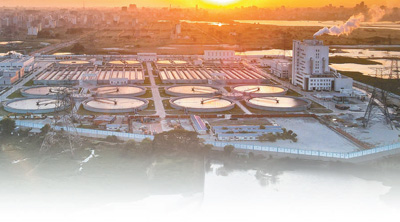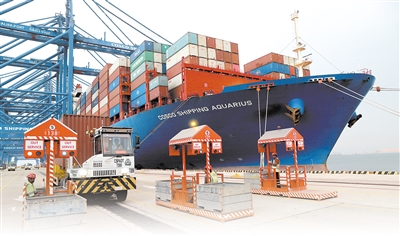The Hinterland Becomes The Frontier Of Openness (new Window)
The Hinterland Becomes The Frontier Of Openness (new Window)
Securities Times, Securities Times Network, hosted by the People's Daily, is an authoritative information disclosure media in the securities market and an important information disclosure platform in China's capital market. Provides 24/7 financial and securities information with rich content

Figure ①: Products produced by a company in Xinjiang are exported to the United Arab Emirates, New Zealand, Thailand and other countries.
Photo by He Long
Figure ②: Horgos customs officers provide services to ensure the export of commercial vehicles.
Photo by Wang Baiyu
Figure ③: Alashankou Customs officers supervise the transportation tools at the railway port.
Photo by Zhang Zhaohui
Figure 4: The busy marshalling yard of Alashankou Station in Xinjiang.
Photo by Chen Qian
Xinjiang gives full play to its advantages in the core area of the Silk Road Economic Belt, strives to build a golden corridor between Asia and Europe and a bridgehead for opening up to the west, and builds a new development pattern with high-level open services. Xinjiang's foreign trade has achieved rapid growth, thanks to the construction of a high-level open platform, the continuous improvement of the port business environment, and the efficient and smooth international logistics channels. In the future, as the institutional environment is further optimized and connectivity with neighboring countries deepens, the inland hinterland will play an even more important role in the high-level opening up pattern.
——Editor
At the Xinjiang Horgos highway port centralized inspection site, at 10 a.m., the lane in front of the gate was already busy. There were transport trucks carrying 80-meter-long wind turbine blades, and cold chain transport trucks filled with fruits and vegetables. The largest number were new energy vehicles that were about to be exported to Central Asian countries. Central Asian agricultural products such as honey, fruits, and wheat also entered the Chinese market from here;
At the China-Europe freight train assembly center in the Urumqi International Dry Port Area, clothing and department stores, machinery and equipment, and auto parts from Guangzhou, Zhejiang Yiwu and other places are being assembled and shipped. After customs inspection and sealing, they will be carried by Xinjiang's local freight train brand "Tianshan" across the mountains and seas and exported to Central Asian countries;
…………
These scenes full of vitality are a vivid reflection of Xinjiang’s unswerving efforts to expand high-level opening up to the outside world.
General Secretary Xi Jinping emphasized: “Accelerate the construction of the core area of the Silk Road Economic Belt and play a greater role in promoting domestic and international dual circulation.”
From the inland hinterland to the frontier of opening up, in recent years, Xinjiang has given full play to the advantages of the core area of the Silk Road Economic Belt, strived to build a golden corridor between Asia and Europe and a bridgehead for opening to the west, promoted rapid growth in foreign trade, and built a new development pattern with high-level open services. According to Urumqi Customs statistics, during the "14th Five-Year Plan" period, Xinjiang's total foreign trade import and export value has continuously crossed three hundred billion yuan levels, with an average annual growth rate of 40% from 2021 to 2024. In the first eight months of this year, Xinjiang’s total foreign trade import and export value was 356.31 billion yuan, an increase of 25.4%, which was 21.9 percentage points higher than the national growth rate, showing strong development momentum.
Innovate supervision models to improve customs clearance efficiency
In Horgos, Xinjiang, Wang Xianguo is a "ferryman" for domestically produced new energy vehicles. He drives a new domestically produced vehicle out of the country, delivers it to Kazakhstan for acceptance, and then returns on a transnational passenger bus. "The current job is relatively flexible. I can take advantage of the slack time to run sports cars, and the income is relatively stable." Wang Xianguo said.
Domestic new energy vehicles are selling well in the Central Asian market, giving rise to the profession of automobile "ferryman". In Horgos, there are nearly 4,000 domestic car "ferrymen" like Wang Xianguo. The new car driven by Wang Xianguo is a new energy vehicle that Horgos Haocheng International Freight Forwarding Co., Ltd. will export to Kazakhstan.
"China's new energy vehicles are very popular in Central Asia and the Middle East. Not only do they have excellent performance, but they are also equipped with many new functions and are very popular among young people." Liang Hao, general manager of Haocheng Company, said that before, the company exported more than 4,000 vehicles per year, which has increased to about 20,000 vehicles in the past two years. In the first eight months of this year, the company exported more than 12,000 vehicles, and the trade volume increased by about 10% year-on-year.
As the country’s largest land port for automobile exports, the number of automobiles at the Horgos Port has continued to grow since this year. According to Horgos Customs statistics, from January to August, Horgos Port exported 258,000 vehicles, a year-on-year increase of 8.5%, a record high, of which the number of exported electric vehicles increased by 45.2% year-on-year.
"Compared with traditional cage car transportation, delivering cars through the 'ferryman' is more flexible and efficient, and the transportation cost is also low. It is increasingly favored by foreign car importers." Liang Hao said.
Changes in corporate needs have put forward new requirements for customs clearance models. Horgos Customs has taken a series of measures to optimize the customs clearance process, innovate the supervision model, implement a 24-hour freight customs clearance work system, and create the first "self-driving export commodity vehicle rapid customs clearance model." Under this mode, each export commodity vehicle has a QR code. After the vehicle arrives at the port, it can be quickly released after being identified by the smart bayonet camera. The overall customs clearance time at the port has been reduced from more than 30 hours to less than 5 hours, and the customs clearance efficiency has increased by 80%.
As more and more "Made in China" products move from Xinjiang to the international market, higher requirements are placed on the facilitation of cross-border trade. Customs, commerce and other departments are promoting reforms to improve quality and efficiency and better respond to the demands of enterprises.
For large wind power equipment that is oversized and oversized, Horgos Customs and Kazakhstan Customs opened special channels to ensure "straight out and straight in" for the equipment; at Horgos and Alashankou, the two international railway port stations open to the west, the local customs implemented the "smart railway port territorial rapid customs clearance" reform to ensure the convenient and efficient passage of China-Europe (Central Asia) trains. In order to allow more vegetables and fruits to be transported in a timely manner, the customs has achieved full coverage of the "green channel" for rapid customs clearance of agricultural and sideline products at border ports in Central Asian countries, and innovatively applied "green customs locks" for agricultural and sideline products. Fresh fruits can arrive at the Kazakhstan market on the same day. In the first eight months of this year, Xinjiang's agricultural product exports increased by 28.6% year-on-year.
As an important gateway for my country's opening to the west, the China (Xinjiang) Pilot Free Trade Zone was approved for establishment in 2023. More than 9,000 new companies will be added in 2024, and the total import and export volume will account for more than 30% of Xinjiang. At present, Xinjiang already has 4 comprehensive bonded zones and 4 comprehensive cross-border e-commerce pilot zones, which have attracted a large number of key enterprises to settle in the region, forming industrial clusters such as automobile assembly, cold chain logistics, and food processing.
Weave dense logistics channels to reduce trade costs
The air road network is getting denser and denser: On April 17 this year, the north terminal area of Urumqi Tianshan International Airport was put into operation. After the "expansion", Tianshan Airport has 285 passenger and cargo routes, connecting 27 countries and 40 cities. Since the beginning of this year, international cargo and mail throughput has increased by 446%.
Railway lines are crisscrossed and busy: As an important hub connecting the two major economic circles of Asia and Europe, Xinjiang's local China-Europe freight train "Tianshan" operated by the Urumqi International Dry Port Area has operated 21 routes, reaching 19 countries and 26 cities in Central Asia, the Middle East, and Eastern Europe, and exporting more than 200 types of goods.
Highway passages connect the inside and outside: "Five ports connect eight countries, and one road connects Europe and Asia." Xinjiang has 21 ports approved by the country for opening to the outside world, and 19 have been opened so far, including 14 highway ports. Like bright pearls, they are scattered in northwest China and have become an important channel for interconnection with neighboring countries. There are 119 bilateral international road transport routes between Xinjiang and Europe, accounting for more than one-third of the country's total.
From "remote areas" to "hub areas", the "arteries" of Xinjiang's transportation network have become smoother, and multi-modal transport modes such as rail, air, highway, and sea have continued to mature, building a three-dimensional transportation system of "linkage between land and sea at home and abroad, and mutual assistance between east and west", and continue to promote the rapid growth of foreign trade.
Xinjiang Wanshengtong Supply Chain Management Co., Ltd. is a cross-border e-commerce enterprise. In the past, because Xinjiang's airport had few air routes, companies had to transport goods to other provinces for centralized shipment. In June 2024, the bonded aviation fuel storage tanks in the Urumqi area of the Xinjiang Pilot Free Trade Zone were officially put into operation, bringing opportunities for the opening of new international routes. Liu Jingyi, Deputy Commissioner of Customs at Urumqi Tianshan Airport, said: "Bonded jet fuel is a 'key variable' in reducing costs for international cargo routes. We have accelerated the implementation of the policy and put it into use 459 working days earlier than originally planned, attracting more airlines to open routes that stop at or to and from Urumqi. The total amount of bonded jet fuel has exceeded 100,000 tons."
"Some aircraft models need to fill up with 80 tons of fuel to fly to Europe. After the introduction of the bonded aviation fuel policy, more than 100 US dollars in fuel costs can be saved per ton. The cost savings are enough to cover the logistics costs of transportation from the South China and East China markets to Urumqi." said Wang Tianzhu, general manager of Xinjiang Wanshengtong Supply Chain Management Co., Ltd.
Optimization of logistics methods brings rapid development of enterprises. "In the past, the company's monthly cross-border e-commerce freight volume was 500-1,000 tons; now the monthly freight volume has exceeded 5,000 tons. It is about to enter the peak season, with an average of 10 flights flying to various parts of the world every day." Wang Tianzhu introduced. Today, at Urumqi Tianshan International Airport, more than 200 tons of cross-border e-commerce goods are loaded onto planes and shipped to all parts of the world every day.
Currently, there are more than 200 cross-border e-commerce related companies in Urumqi. On May 24 this year, Urumqi Customs released 10 measures to promote the development of cross-border e-commerce, focusing on issues such as customs clearance timeliness and logistics costs, and introduced a series of support measures. Data from the Customs cross-border e-commerce management platform show that from January to August this year, Urumqi’s cross-border e-commerce exports were 8.87 billion yuan, an increase of 185.6%.
Optimize the business environment and create an open highland
At dawn, the Irkeshtan Port located in Wuqia County, Kizilsu Kirgiz Autonomous Prefecture, Xinjiang is already a busy and orderly scene. Large trucks loaded with containers pass through the exit checkpoint in an orderly manner, heading for Kyrgyzstan.
Irkeshtam Port is the westernmost port in China, corresponding to Irkeshtam Port in Kyrgyzstan. It is an important land port connecting my country to Central Asian countries. With the construction of the China-Kyrgyzstan-Uzbekistan Railway in full swing, a large number of engineering machinery and equipment enter and leave the port, and the role of the Irkeshtan Port has become even more prominent.
"Our company's export products are mainly engineering machinery and building materials. Since the construction of the China-Kyrgyzstan-Uzbekistan Railway began, the export volume of machinery and equipment has greatly increased. Last year, 50,000 tons were exported. From January to August this year, the export volume has reached 70,000 tons, and the overall freight volume has increased by 30%." said Di Li, manager of Kashgar Wulian Eurasian Logistics Co., Ltd.
Meats, fruits, grains, etc. enter the Chinese market through the Irkeshtan Port, and Chinese daily necessities, small electrical appliances, auto parts, clothing, and engineering instruments are also shipped to Central Asian countries from here. As port freight volume continues to break through record highs, in June this year, Irkeshtan Port took the lead in launching a 24/7 freight customs clearance trial model, promoting the "road port territorial direct access" model to reduce the time vehicles wait in line at the port.
Abu Sahei Company is a local company in the Kizilsu Kirgiz Autonomous Prefecture. The person in charge of the company, Aili, said: "This year has been very busy. So far, our company has exported 250,000 tons of daily necessities and almost 75,000 tons of engineering equipment. Compared with last year, the company's overall freight volume has increased by 20%. But now there are fewer customs clearance procedures. It only takes 30 minutes to get a car out, and the cost has been reduced by 25%."
Irkeshtan Customs statistics show that from January to August this year, a total of 1.869 million tons of import and export goods were under supervision, a year-on-year increase of 67.4%. After optimization and adjustment of the customs clearance process, the export customs clearance process has been optimized from 12 items to 4 items. The customs clearance time only takes 30-40 minutes, with a compression rate of 66.7%.
As the import and export trade of goods continues to grow, various localities and relevant departments in Xinjiang continue to optimize the business environment and improve regulatory efficiency and service levels.
At the Alashankou Railway Port, large-scale container inspection equipment can complete a panoramic scan of a container within 5 minutes, and the inspection time for a single container is shortened by more than 90% compared with manual methods; at the Urumqi International Dry Port Area, the customs comprehensively uses the "railway express" mode, advance declaration, appointment customs clearance, and direct loading on arrival to facilitate a series of procedures. The customs mode has improved the efficiency of trains by more than 30% and reduced the cost of each container by 200 yuan; at Turgat Port, the construction of the China-Kyrgyzstan-Uzbekistan Railway has driven a significant increase in the number of outbound people, and the customs has adopted "appointment customs clearance smart travel inspection" to achieve seamless customs clearance... The level of cross-border trade facilitation has continued to improve, helping Xinjiang move towards the forefront of opening up.





